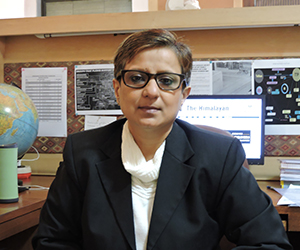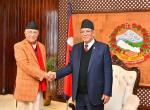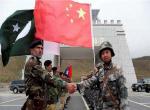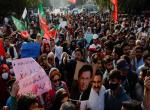Newly elected President of Sri Lanka Maithripala Sirisena’s visit to India from Feb 15-18 had justifiably raised hopes and expectations, both in Colombo and in New Delhi, of a major‘course correction’ that could mark the onset of a new, vigorous and dynamic bilateral relations between the two countries. The reasons for such high expectations were many. To mention just a few, the new President had in a very significant gesture chosen New Delhi as the destination for his first bilateral visit after the ‘historic’ elections last month in which he put paid to the quest of the outgoing President Rajapaksa for a record third term in office. Equally important was the fact that the later part of Rajapaksa’s presidency was marked by an almost deliberate attempt to shift the delicate balance in Sri Lanka’s foreign policy approach away from India, in favour of China. There was also considerable disenchantment amongst the Sri Lankan minorities and in a section of the Indian populace on issues relating to devolution and rehabilitation in the war-ravaged North and North-eastern parts of Sri Lanka.
Diplomatic signals emanating from Colombo suggested that the new administration of President Sirisena was keen on restoring the desired ‘balance’ in his government’s foreign policy approach involving India and China. In this context, it may be recalled that the President had only recently, in his Independence Day speech said, “In considering the past, we make a clear commitment towards following a foreign policy of middle path, in friendship with all nations”. It was, therefore, reasonable to expect that Sirisena’s visit could mark a major readjustment in bilateral relations that could restore the balance. There was also the larger expectation that the two leaders, President Sirisena and Prime Minister Narendra Modi would not only address the afore stated concerns but also explore ways and means of enhancing economic cooperation between the two countries in a spirit of partnership (Sabka Saath Sabka Vikas) to realise their aspirations within the frame work of SAARC and in the bilateral format.
In this back ground, the two leaders did agree to initiate a slew of measures to give a new direction to the relationship. The most notable amongst these was the Agreement on Co-operation in the Peaceful Uses of Nuclear Energy. It may be recalled that Sri Lanka has been looking for assistance for its peaceful nuclear programme in the fields of energy, industry, medicine and agriculture for over five years and eventually, decided to opt for Indian assistance over the Pakistani and Chinese overtures in this regard. This has been interpreted by analysts as a mature and significant shift in strategic relations between the two countries. According to the agreement, the two countries would exchange knowledge and expertise, share resources and undertake capacity building and training of personnel in peaceful uses of nuclear energy.
Another important agreement provides for enhanced level of defence and security cooperation in the existing trilateral format with the Maldives. Analysts believe that under this arrangement, a number of pending issues could come up for review, possibly even incidents such as security concern emanating from the recent docking of a Chinese submarine in the Colombo harbour. The two leaders also agreed to expand cooperation in a number of sectors including energy, trade, investment, agriculture and healthcare. The perennial problem of fishermen on both sides of the Palk Straits was discussed and Prime Minister Modi and President Sirisena pledged to resolve these in a “constructive and humanitarian” way.
Significantly, no specific mention was made in the joint press release on the contentious issues of relief, reconstruction, rehabilitation and devolution in the North and North-east. It is suggested that the two leaders did discuss these but preferred to keep it out of the public domain for ‘very good reasons’. It is understood that on these issues as well, the engagement was constructive and the new government would start unveiling its new approach in the months ahead.
This could well happen under the programme already initiated by the new administration. In this context, it is mentioned that the government had already started moving with a sense of purpose and urgency in fulfilling the promises it had made to the people in the election manifesto. The 100 Days Reform Project was not just about the letter of the promises made but also the spirit in which it wanted to translate these into practice. It flagged the beginning of reversal of the ‘damages’ done by the previous regime. The prevailing view is that the twin leadership of Sirisena and Wickremesinghe, the new Prime Minister, can deliver. They seem to have the political will and the capability to decide the fundamental issues that had riddled the nation in the past and move ahead in ‘favour of the people’. A new Chief Justice, Shri Sripavan, has been appointed; the first member of the minority Tamil community to hold the post in more than two decades. A new civilian Governor has also been appointed for the Tamil-majority Northern Province. The Government has also announced lifting of the ban on foreign nationals visiting the Island’s former war zone. Economic embargo in the Tamil-majority area has also been scrapped. The reconstruction of railway line up to Jaffna is yet another milestone. Services to Jaffna were resumed recently after a gap of 24 years.. It is a landmark achievement and reflects the sensitivity of the government towards the people of that region.
The President has also pledged to grant autonomy to the Island’s former northern war zone where members of the ethnic Tamil minority predominantly reside. There has to be a meaningful devolution of power building on the 13th Amendment to the Sri Lankan Constitution, so that it can create necessary ground conditions for a lasting political settlement. The ethno-social fabric of the Sri Lankan society which was in a bad shape can now see a ray of hope for repair and restoration. Further, there is a pressing need for the Internally Displaced Persons to be resettled in their original habitation. The need for reconciliation through political settlement of the ethnic issues has been reiterated by India at the highest level.
One of the issues that New Delhi would be watching closely is Sri Lanka’s China policy. This had created an uneasy and awkward frosting of relations between India and Sri Lanka in the previous regime. There should be no illusion in New Delhi that the new regime in Colombo will stop building major projects with Chinese collaboration. China has entered Sri Lanka and its strategic geo-space in a very significant way. A total reversal in this sphere appears improbable, indeed impractical. . A great deal has been written and documented by very knowledgeable experts on the China factor in India- Sri Lanka relations. It is not our intent to catalogue these all over again. The fact remains that over the last 5-6 years, China has been aggressively pushing its way, largely successfully, into Sri Lanka’s key infrastructure projects through its state owned entities being ‘used’ by the Chinese authorities to the detriment of legitimate Indian interests. This trend continued unabated during Rajapaksa’s rule despite high level political persuasions.
It is certainly not India’s case to, in any way, undermine Sri Lanka’s rightful choice of picking its partners for normal commercial deals. It may also be mentioned that similar trends have been noticed in the entire neighbourhood in varying measures and these are likely to continue. What India would be looking for is a level playing field approach in the normal economic and commercial dealings with some concern for its sensitivities in projects that have implications for its security. India would also be justified in its expectation of better appreciation by its neighbours with whom it has special relations, particularly in Sri Lanka, having stood by that country in difficult times. Developmental and security co-operation form the most important cornerstone of our relationship. The edifice of this bond is the mutual trust and implicit faith which the two nations have had for one another.
The task is not going to be easy for both Mr. Modi and Mr. Sirisena. But the intent to develop a partnership approach seems to be obvious. Some significant forward movement is already noticeable and the ground has been set for more to follow. The Sri Lankan Foreign Minister, Mangala Samaraweera, had during his recent visit said that Sri Lanka would like to start its relationship with India on a clean state. India has been assured of these new priorities of Sri Lanka. And now the engagement is slated to move forward on a fast track with the new Foreign Secretary and the Indian Foreign Minister due to visit Colombo next month followed by PM Modi also doing so in March’15. The recent high level engagements between the two countries have given reasonable hope for a new chapter being opened in India-Sri Lanka relations.
Published Date: 27th February 2015, Image source: http://www.oneindia.com
(Disclaimer: The views and opinions expressed in this article are those of the author and do not necessarily reflect the official policy or position of the Vivekananda International Foundation)









Post new comment